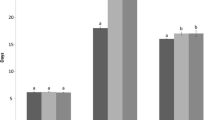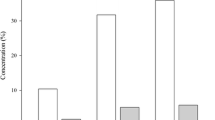Abstract
The legume pod-borer, Maruca testulalis was reared in the laboratory for 10 successive generations using a semi-synthetic diet. The diet was composed of locally available soybean flour and cowpea flower powder as basal ingredients. The artificial medium was as suitable as the cowpea host plant for M. testulalis in supporting larval growth and development. Fecundity increased with advancing generations on the artificial medium. Field collected pupae were heavier than diet-reared pupae. However, the fecundity, fertility, adult life span, and sex ratio did not differ between the two rearing regimes. The laboratory-reared insects were of acceptable uniform quality and predictable performance even after 10 successive generations of laboratory rearing. Adult emergence ranged between 70–90%. One litre of diet produced on average 400 pupae or adults with a mean fecundity of 200 eggs per female. One person working 8 hr/day can produce a minimum of 1000 healthy pupae or adults daily. The laboratory rearing management protocol is described.
Résumé
Dix générations du foreur de cosses de légumineuses, Maruca testulalis ont été élevées au laboratoire, sur un milieu semi artificiel. Les principaux ingredients de ce milieu ont ete la farine de soja et la poudre de fleurs de niébé. Ce milieu a pu supporter le développement et la croissance larvaire de M. testulalis aussi convenablement que le milieu naturel. Une augmentation en fécondité a été observée au fur et à mesure qu’on a avancé dans le nombre de generations. Bien que le poids des pupes obtenues en milieu de culture naturel ait été plus élevé que celui des pupes obtenues en milieu artificiel, la fécondité, la fertilité, la durée de vie de l’adulte et le rapport maie/femelle n’ont montré aucune différence. Les insectes élevés en laboratoire ont été de qualité acceptable et de performance prévue même après dix générations successives. L’émergence des adultes a varié entre 70–90 %. Un litre de milieu nutritif produit en moyenne 400 pupes ou adultes avec une fécondité moyenne de 200 oeufs par femelles. Une personne travaillant 8 hr par jour pourrait produire un minimum de 1000 pupes/adultes sains. Un protocole de gestion de cet élevage en laboratoire est décrit.
Similar content being viewed by others
References
Gokhale, V. G. (1973) Developmental capacity of several pulses to Bruchidae—1. Growth and development of Callosobruchus Maculatus (Fab.) on host seeds. Bull. Grain Technol. 11, 28–31.
Jackai, L. E. N. and Raulston, J. R. (1982) Rearing two maize stem borers and a legume pod borer on artificial diet. UTA Res. Briefs 3, 1–6.
Jackai, L. E. N. and Raulston, J. R. (1988) Rearing the legume pod borer, Maruca Testulalis Geyer (Lepidoptera: Pyralidae) on artificial diet. Trop. Pest Manage. 34, 168–172.
Ochieng’ R. S., Okeyo-Owuor, J. B. and Dabrowski, Z. T. (1981) Studies on the legume pod borer, Maruca Testulalis (Geyer)—II. Mass-rearing on natural food. Insect Sci. Applic. 1, 269–272.
Ochieng’ R. S. and Bungu M. D. O. (1983) Studies on the legume pod-borer, Maruca Testulalis (Geyer)—IV. A model for mass rearing: Rearing on artificial diet. Insect Sci. Applic. 4, 83–88.
Singh, S. R. and Allen, D. R. (1980) Pests, diseases, resistance and protection in cowpea. In Advance s in Legume Science (Edited by Summerfield, R. J. and Bunting, A. H.), pp. 419–443. Her Majesty’s Stationery Office, London.
Singh, S. R. and Taylor, T. A. (1978) Pests of grain legumes and their control in Nigeria. In Pests of Grain Legumes: Ecology and Control (Edited by Singh, S. R., Van Emden, H. F. and Taylor, T. A.), pp. 99–111. Academic Press, London, New York.
Taylor, T. A. (1978) Maruca testulalis: An important pest of grain legumes, Pests of Grain Legumes: Ecology and Control, (Edited by Singh, S. R., Van Emden, H. F. and Taylor, T. A.) pp. 193–200.
Author information
Authors and Affiliations
Rights and permissions
About this article
Cite this article
Onyango, F.O., Ochieng’-Odero, J.P.R. Laboratory Rearing of the Legume Pod Borer, Maruca Testulalis Geyer (Lepidoptera: Pyralidae) on a Semi-Synthetic Diet. Int J Trop Insect Sci 14, 719–722 (1993). https://doi.org/10.1017/S174275840001818X
Received:
Accepted:
Published:
Issue Date:
DOI: https://doi.org/10.1017/S174275840001818X




